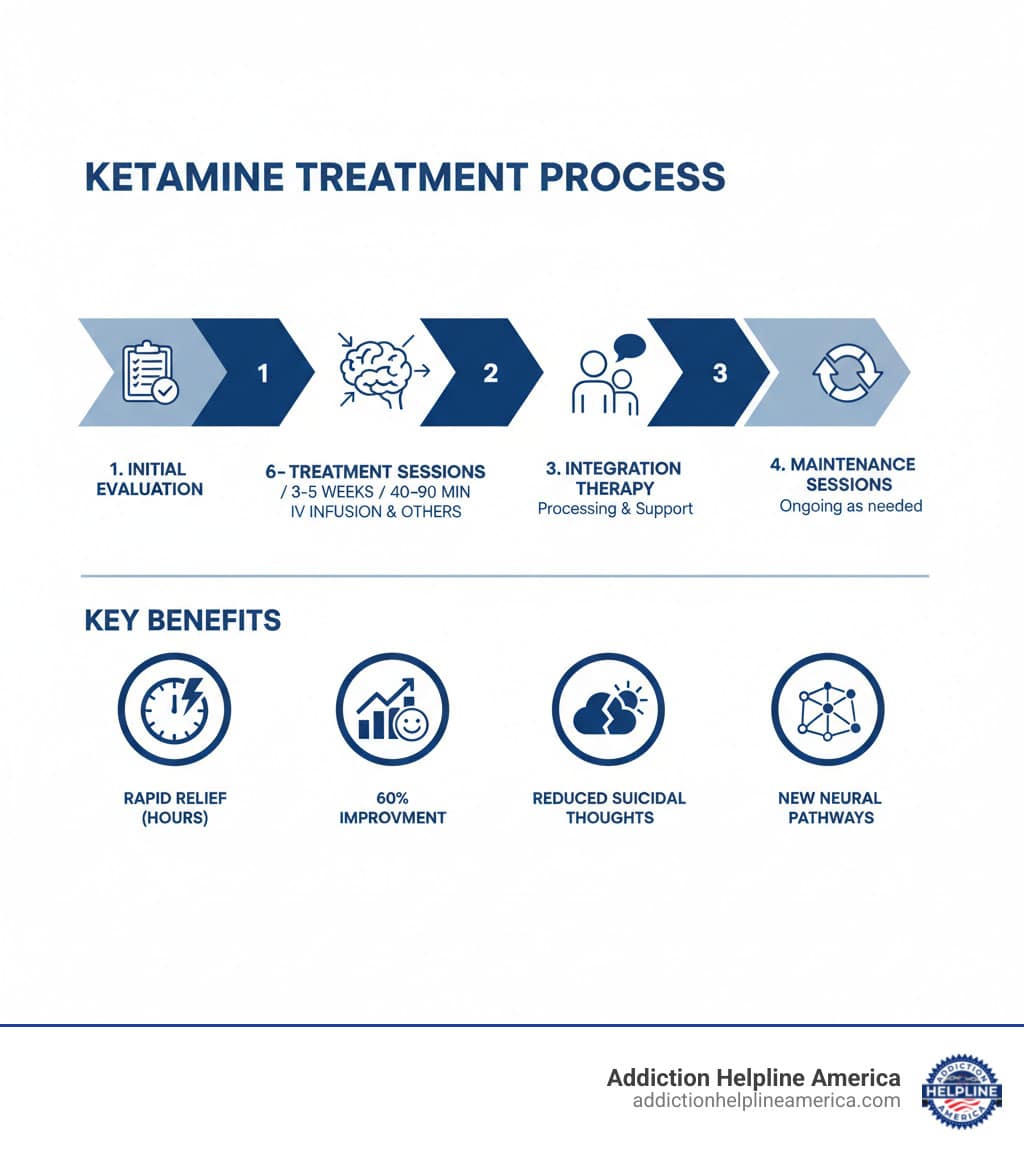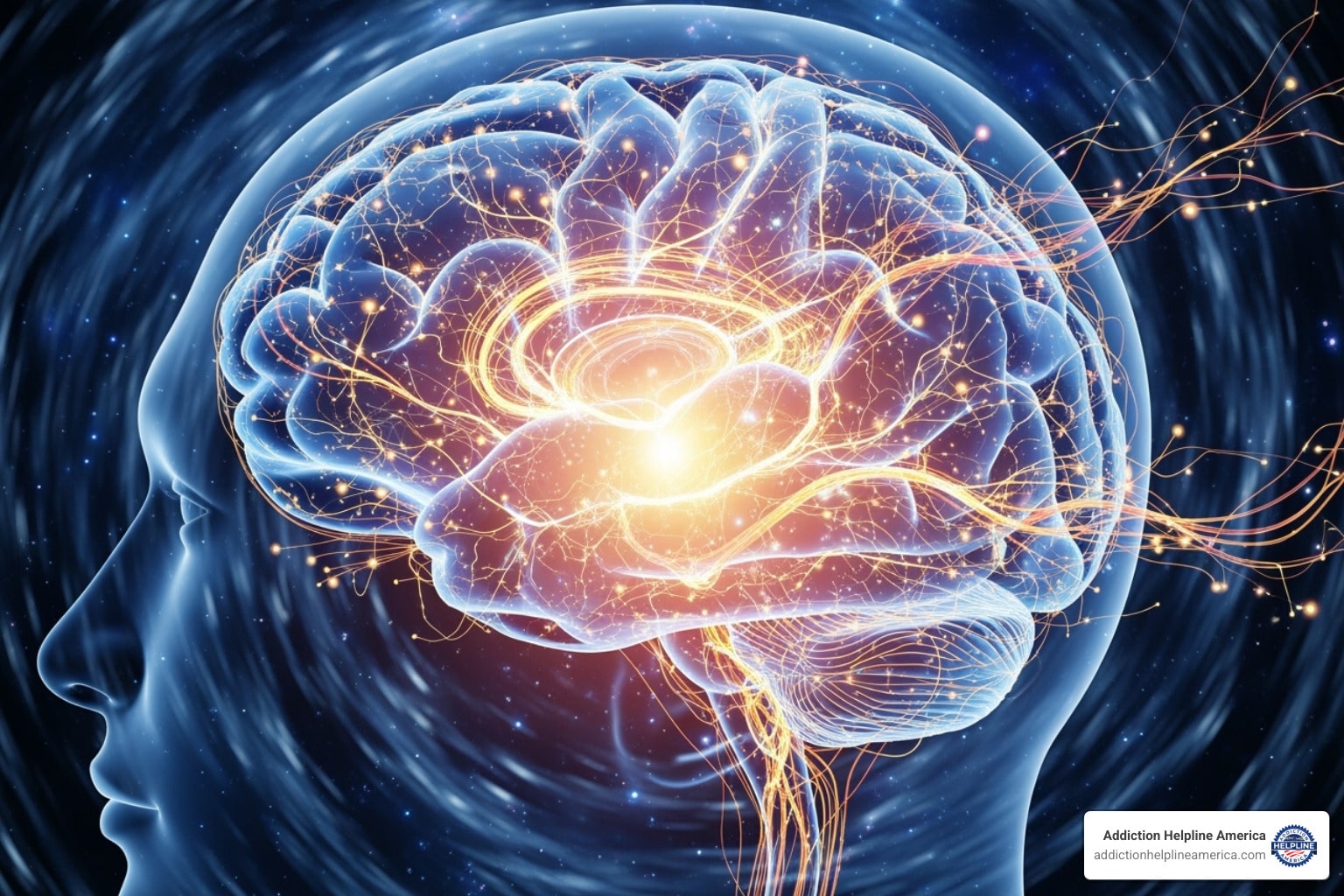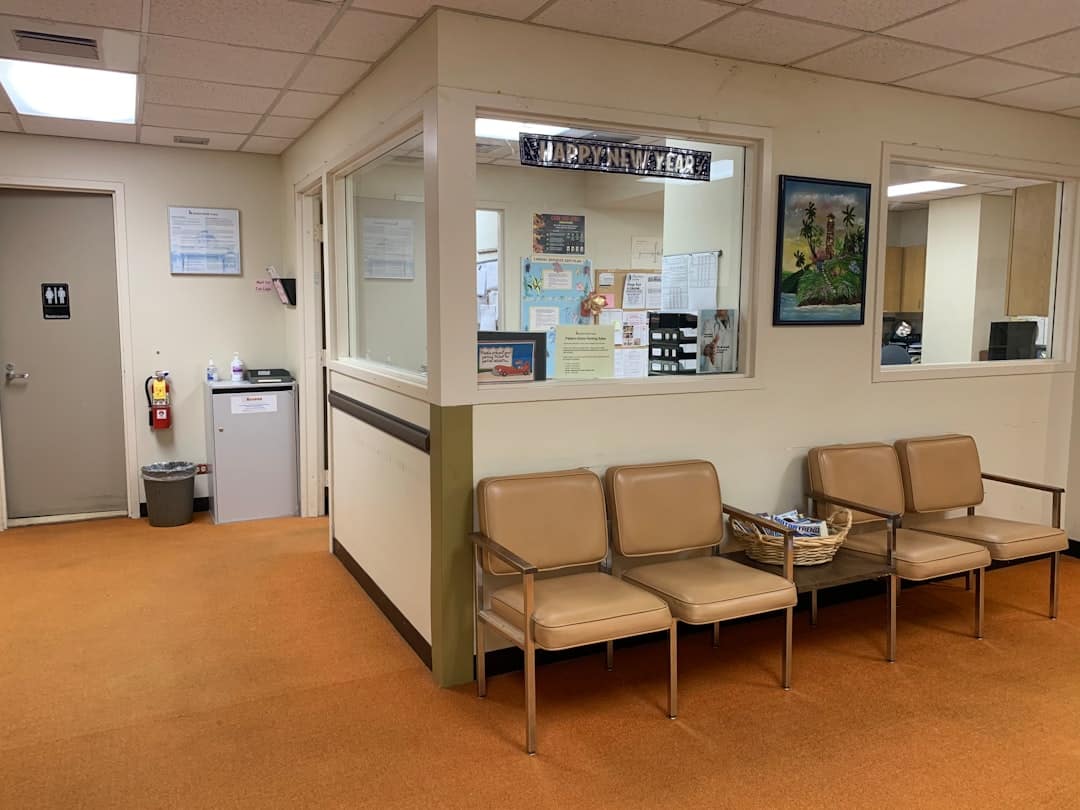Your Journey to a Healthier Life Starts Here
Free Insurance Verification
Verify Your Treatment Coverage
Verify Your Treatment Coverage
Ketamine Treatment is a medical intervention that uses controlled doses of ketamine—a dissociative anesthetic—to rapidly treat severe mental health conditions, particularly treatment-resistant depression, anxiety, PTSD, and suicidal ideation. Unlike traditional antidepressants that can take weeks or months to work, ketamine often produces noticeable relief within hours to days.
Quick Overview of Ketamine Treatment:
Jeff Winograd couldn’t get off his couch. After 25 years of struggling with depression and trying countless medications, he felt paralyzed. “I was suicidal,” he says. “I would sit and try to figure out how I was going to do it without hurting my kids.” Then he tried ketamine therapy—and it saved his life.
Ketamine represents a paradigm shift in mental health treatment. Originally developed as an anesthetic in the 1960s and approved by the FDA in 1970, ketamine has emerged as a breakthrough therapy for people who haven’t found relief through traditional treatments. Its rapid-acting effects offer hope where other medications have failed.
For individuals and families devastated by treatment-resistant depression or other severe mental health conditions, ketamine therapy provides a new path forward. Unlike conventional antidepressants that work on serotonin and can take 4-6 weeks to show results, ketamine targets the glutamate system and can bring relief within hours.
This comprehensive guide will help you understand:
The landscape of ketamine treatment has evolved dramatically. As of 2023, over 2,000 clinics in the United States offer ketamine therapy for psychiatric care. In 2019, the FDA approved intranasal esketamine (Spravato) specifically for treatment-resistant depression, marking the first psychedelic-related drug approval for mental health in decades.
However, not all ketamine treatments are equal. The rapid proliferation of clinics has raised important questions about safety, quality, and appropriate use. Some facilities operate with minimal oversight, while others integrate ketamine into comprehensive treatment programs with proper medical supervision and therapeutic support.
At Addiction Helpline America, we’ve supported countless individuals and families navigating complex treatment decisions for mental health and substance use disorders. Our team understands the urgent need for effective Ketamine Treatment options and can help you find reputable providers and resources. We’re here to provide the confidential guidance you need to make informed decisions about your care or that of a loved one.

Ketamine’s journey from a battlefield anesthetic to a mental health breakthrough is remarkable. Approved by the FDA in 1970 for anesthesia, researchers later finded that low doses could rapidly lift severe depression, offering hope to people who had tried everything else. This signals a fundamental shift in treating mental illness, as ketamine works on a completely different brain pathway than conventional medications.
Traditional antidepressants, like SSRIs, can take four to six weeks to work, a frustrating cycle for those who don’t find relief. This is known as treatment-resistant depression, affecting about one-third of people with major depressive disorder.
Ketamine Treatment changes this equation. Instead of waiting weeks, patients often feel improvement within hours. It targets the brain’s glutamate system, which is crucial for mood regulation, rather than the serotonin system. For someone in crisis or battling suicidal thoughts, this rapid action can be lifesaving. As psychiatrist Dr. Brandon S. Hamm notes, ketamine serves as “a more aggressive treatment for people with major and bipolar depression who have tried multiple antidepressant medications without success.” It offers real relief when other doors have closed.
In a clinical setting, ketamine temporarily blocks the brain’s NMDA receptors. This triggers a “glutamate surge,” rapidly stimulating nerve cells in areas that regulate mood. This process kicks off synaptogenesis—the growth of new connections (synapses) between brain cells.
Chronic depression can weaken or sever these connections. Ketamine helps rebuild them. It promotes neuroplasticity, your brain’s ability to form new pathways and reorganize itself. Think of it as encouraging healthy new growth in a garden, making the brain more flexible and capable of change.
These structural changes continue for days and weeks after the ketamine has left your system. The dissociative effects may last 40-90 minutes, but the biological remodeling continues. Each treatment reinforces this healing process. This mechanism explains why ketamine can succeed where other treatments fail—it addresses the problem at a deeper, structural level by changing how brain cells communicate.

Considering Ketamine Treatment can feel daunting, but understanding the process can ease anxiety. The entire journey takes place in a clinical setting with trained medical professionals, combining medical supervision with therapeutic support for the best results.
Ketamine can be administered in several ways, depending on your condition and your doctor’s recommendation.
Regardless of the method, medical supervision is essential. A psychiatrist determines your dose, and a medical team monitors your vital signs throughout the treatment to ensure your safety.


Take the first step towards a healthier life! Call now to connect with our compassionate team and start your recovery journey today. Your path to healing awaits!
Our recovery specialists are available 24/7 to provide support, and all calls are confidential and free. Reach out anytime – we’re here to help!
Here’s what a typical Ketamine Treatment journey involves.
Preparation: You’ll likely be asked to fast for a few hours to prevent nausea. Bringing headphones with calming music and an eye mask can improve the experience. You must arrange for someone to drive you home, as you cannot drive after treatment.
The Session: In a quiet room, you’ll receive the medication. IV infusions last about 40 minutes. During this time, you may have a “dissociative experience,” feeling floaty, detached, or dreamlike. These sensations are temporary and fade shortly after the session.
Post-Treatment: You’ll be monitored for 30-90 minutes until the immediate effects wear off and your vital signs are stable. You might feel tired or “fuzzy” for a few hours.
Treatment Protocol: Most people begin with an “induction phase” of 6-8 sessions over 3-5 weeks. This is often followed by less frequent “maintenance treatment” (e.g., monthly) to sustain the benefits. Your team will conduct regular re-evaluations to adjust your protocol as needed. For more on protocols, see what Johns Hopkins provides further insights into What to Know About Ketamine.
Ketamine Treatment is most effective when paired with psychotherapy, an approach known as Ketamine-Assisted Psychotherapy (KAP). The medication can create a unique mental state, lowering psychological defenses and making it easier to process difficult emotions and gain new perspectives.
This period of increased neuroplasticity is a prime opportunity for therapeutic work. Integration counseling after a session helps you make sense of your experience and translate insights into lasting change. A therapist can use approaches like Cognitive Behavioral Therapy (CBT) to help you challenge negative thought patterns and build resilience.
Without this therapeutic support, the benefits of ketamine can fade. With it, you can turn neurochemical changes into meaningful, long-term recovery. For more on this integrated approach, explore resources on Ketamine-assisted psychotherapy. We encourage seeking clinics that offer this comprehensive care.
When considering an innovative medical intervention like Ketamine Treatment, it’s crucial to weigh the potential for relief against the genuine risks. An informed decision requires looking at the full picture to ensure your safety and well-being.
Ketamine Treatment has generated excitement because it often works when other treatments have failed. It is most beneficial for:
The primary benefits stem from its rapid antidepressant effects, leading to improved mood, a renewed sense of hope, and improved neuroplasticity for lasting change. A systematic review on ketamine for mental health details the evidence across these conditions.
Most side effects of Ketamine Treatment are temporary and occur under medical supervision. During or immediately after a session, you might experience:
These acute effects are manageable and short-lived. More serious concerns are overwhelmingly associated with chronic, high-dose recreational use, not controlled medical therapy. These include bladder issues (ketamine cystitis) and cognitive impairment. While ketamine has some abuse potential, the risk of addiction is low when used therapeutically under medical supervision. For more details on risks, see our article on Ketamine Abuse: Addiction, Effects, and Treatment and this systematic review on side-effects.
A thorough evaluation is required to determine if Ketamine Treatment is right for you.
Good candidates often include adults with:
The screening process involves a full medical and psychiatric history, physical exams, and lab tests, as outlined by institutions like Northwestern Medicine.
Ketamine should be avoided by individuals with:
Honest communication with your healthcare provider about your full medical history is essential to ensure the treatment is safe and appropriate for you.
Deciding to pursue Ketamine Treatment is a significant step. We want to empower you with the information needed to steer this path, from understanding costs to finding a provider you can trust.

The financial aspect of Ketamine Treatment can be a major hurdle, as most of it is paid out-of-pocket. Because its use for mental health is “off-label,” most insurance plans do not cover IV ketamine infusions.
A single infusion often costs $600 or more, and a full initial course of 6-8 sessions can total $4,500 to $6,000. Ask clinics about payment plans or financial assistance.
The main exception is the esketamine nasal spray (Spravato). Since it is FDA-approved for treatment-resistant depression, insurance is more likely to provide coverage, though you’ll still have co-pays and deductibles. The SPRAVATO® patient website has more information.
Always ask for a detailed cost breakdown upfront and contact your insurance company directly to clarify any potential coverage. Our guide on Rehab Insurance Coverage can offer additional insights.
With over 2,000 clinics in the U.S., choose carefully. A reputable clinic will prioritize patient safety over profit. Here’s what to look for:
Be cautious of mail-order services offering compounded oral ketamine, as the FDA has warned about their risks. For more guidance, you can consult resources like WebMD’s article on Ketamine Treatment for Depression: What to Know. If you feel overwhelmed, our Addiction and Rehab Hotlines can connect you with vetted providers.
Ketamine Treatment is an evolving field. Researchers are investigating its potential for PTSD, OCD, and substance use disorders, as detailed by organizations like the Psychedelic Science Institute. Key areas of current research include understanding long-term effects, optimizing treatment protocols, and determining how best to integrate psychotherapy.
This evolution is moving ketamine from a last resort to a more standard tool in psychiatric care. As the science deepens, we can expect more personalized and effective treatment plans. This systematic review highlights the breadth of ketamine’s potential. At Addiction Helpline America, we are committed to helping make these promising therapies accessible. You can find more information in our resource on Ketamine Treatment.
Ketamine Treatment marks a significant advancement in mental healthcare, offering rapid relief for individuals with severe, treatment-resistant conditions. By promoting neuroplasticity and working best when integrated with psychotherapy, it is changing lives.
We’ve covered how ketamine works, the treatment process, its benefits for conditions like depression and PTSD, and the importance of weighing the risks. Navigating costs and finding a safe, reputable clinic are crucial steps on this journey.
At Addiction Helpline America, we understand the urgency of finding effective mental health solutions. If you are exploring Ketamine Treatment, we are here to provide free, confidential guidance. Our network can help you find a recovery program custom to your unique needs.
Hope is real, and personalized treatment is within reach.
Are you or a loved one struggling with addiction? Call today to speak to a treatment expert.
Calls to any general helpline will be answered or returned by one of the treatment providers listed, each of which is a paid advertiser:
Our helpline is available 24 hours a day, 7 days a week at no cost to you and with no obligation for you to enter into treatment. We are committed to providing support and guidance whenever you need it.
In some cases, Addiction Helpline America charges our verified partner a modest cost per call. This fee helps us cover the costs of building and maintaining our website, ensuring that we can continue to offer this valuable service to those in need.
Calls to the general helpline will be answered or returned by one of the listed treatment providers, all of whom are paid advertisers.
By using the helpline, you agree to the terms of use. We do not earn any commission or fee based on the treatment provider selected by the caller, and there is no obligation to pursue treatment.
This service is not affiliated with Alcoholics Anonymous World Services, Inc.